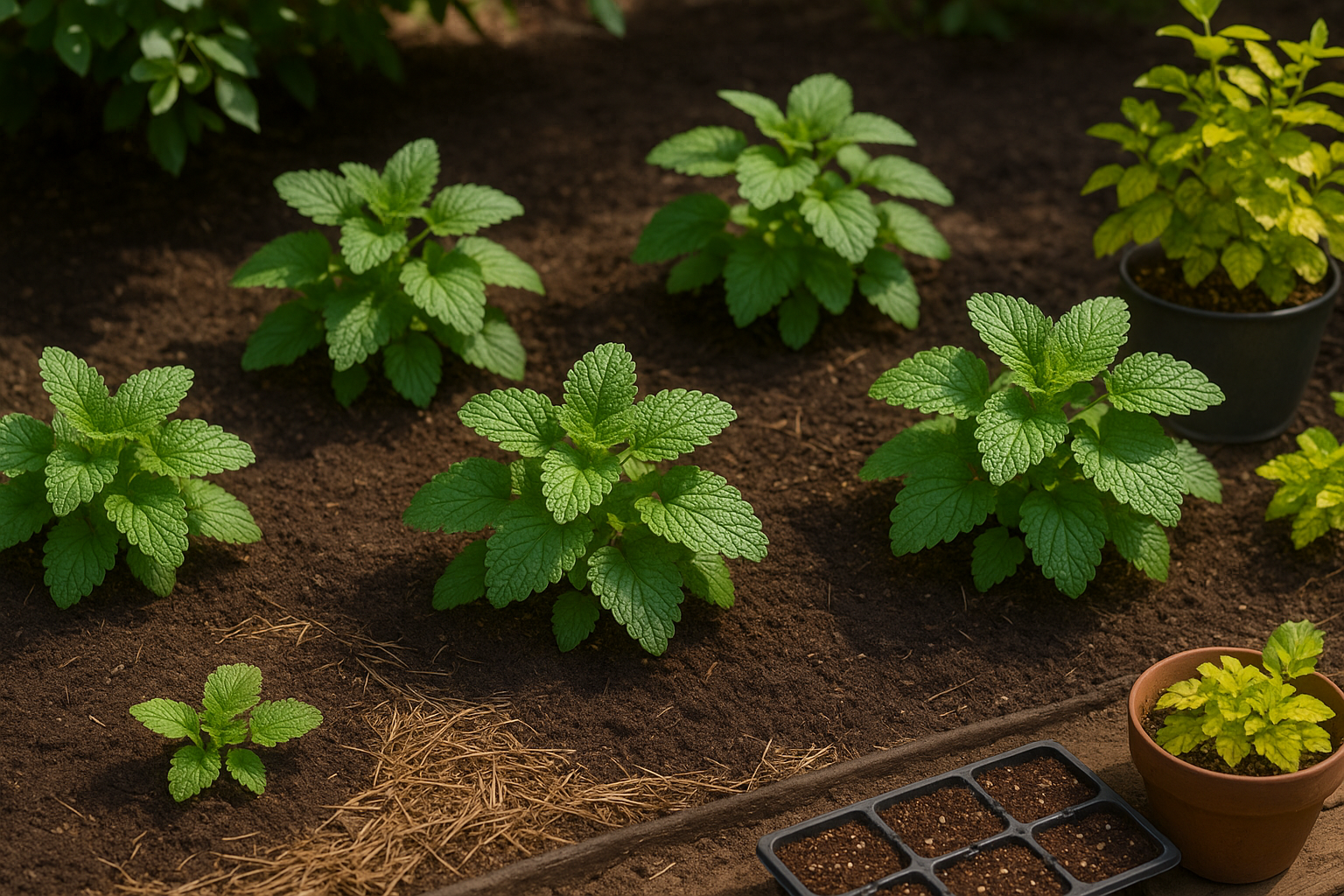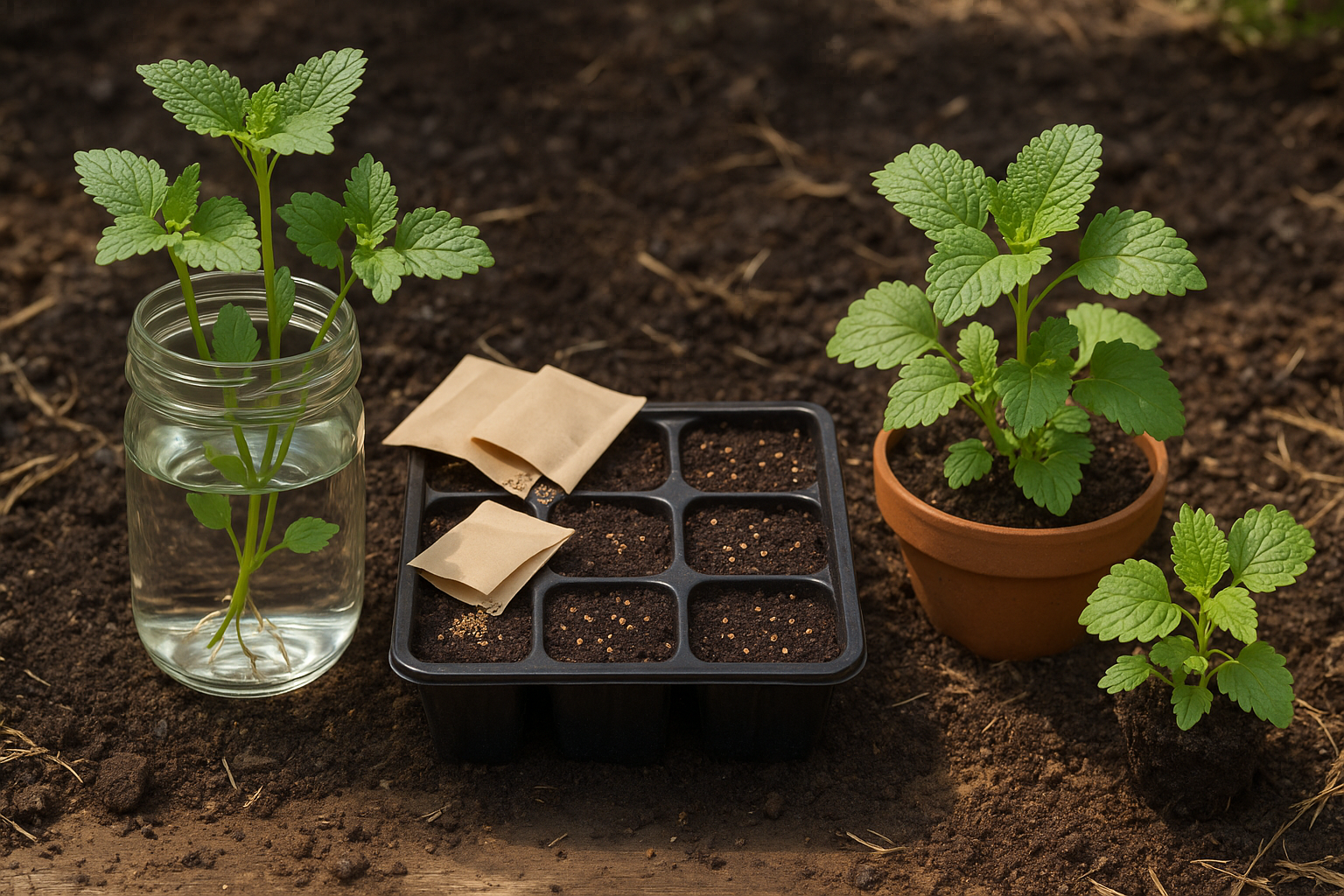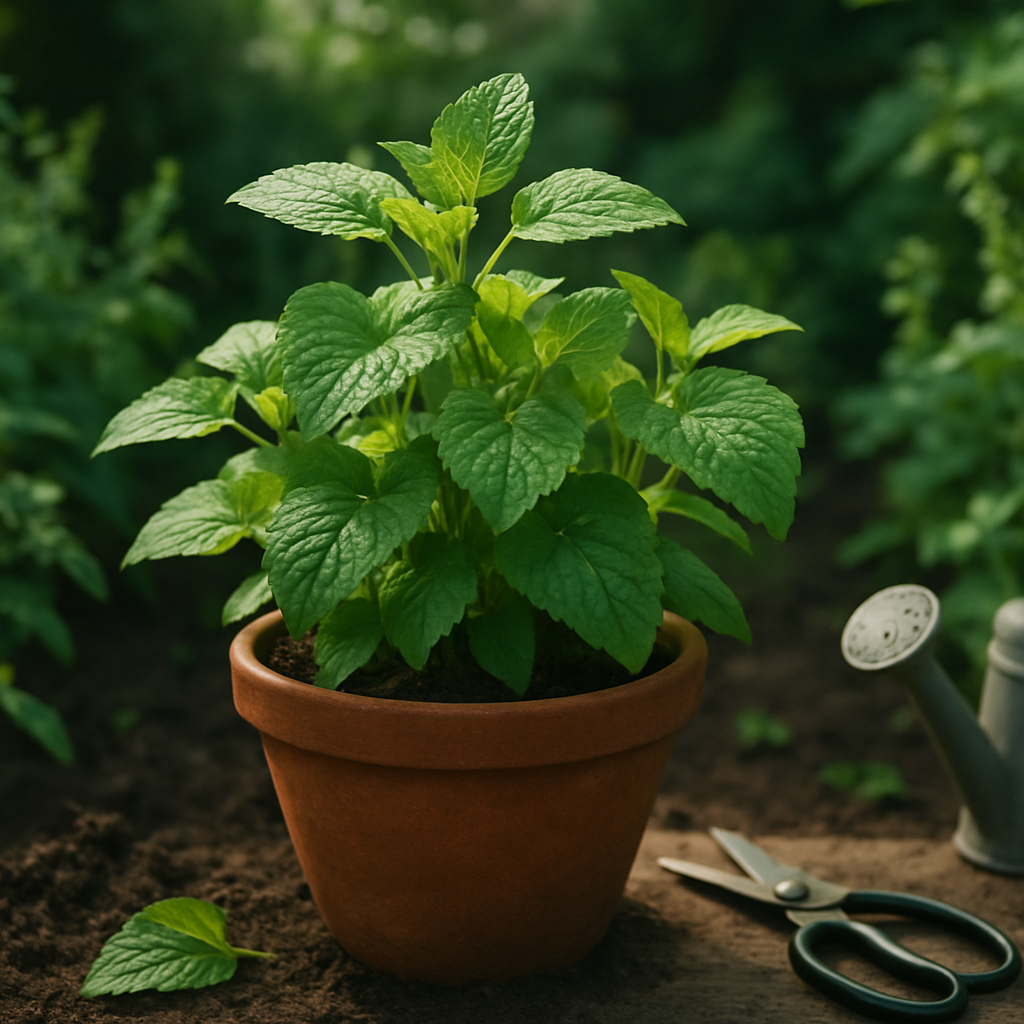Lemon Balm (Melissa officinalis)
Lemon balm is a fragrant herb from the mint family, easily recognized by its bright green, heart-shaped leaves and refreshing citrus scent. Native to Southern Europe and the Mediterranean region, this perennial plant has been treasured for centuries in both gardens and kitchens.
Its undemanding nature makes it perfect for beginner gardeners: lemon balm thrives in various soils, tolerates some shade, and grows vigorously with minimal care. You can start it from seeds, cuttings, or even by dividing mature clumps—making it incredibly adaptable for any garden or windowsill.
Lemon balm isn’t just easy to cultivate; it’s also remarkably versatile. Home cooks love adding its lemony zest to salads, desserts, and marinades, while herbalists praise its calming properties in teas and tinctures, which are said to help with stress and sleep.
In the garden, fresh lemon balm leaves can be rubbed on the skin as a natural mosquito repellent or planted near doors and patios to keep pests at bay. With its attractive foliage and gentle, uplifting aroma, lemon balm is a fantastic addition for anyone seeking a low-fuss, multi-purpose herb that adds both beauty and practical benefits to the home.
When choosing the right location for your lemon balm

Look for a spot that receives at least 5–6 hours of sunlight per day—this herb loves a sunny to partially shaded location for lush, healthy growth. Space is important, too: if planting in the ground, give each plant about 18–24 inches to spread, as lemon balm can get quite bushy.
For small spaces or patios, use a container that’s at least 8 inches deep; this not only saves space but also helps control the plant’s rapid growth, since lemon balm can become invasive in garden beds.
Lemon balm thrives in well-draining soil and prefers a temperate climate—it’s hardy in USDA zones 4–9 and grows as a perennial, coming back year after year. In colder climates, adding mulch in winter helps protect the roots for reliable regrowth.
Choosing the right variety
‘Common’ lemon balm (Melissa officinalis) is the classic choice, offering a strong lemon scent and flavor. For ornamental appeal, ‘Aurea’ boasts gold-flecked leaves, while ‘Lime’ has a distinct citrus twist. ‘Quedlinburger Niederliegende’ features compact growth—ideal for pots.
Consider your space, flavor preference, and garden goals when selecting the right variety for your needs.
Planting Lemon Balm: Easy and Rewarding

Planting lemon balm is easy and rewarding, whether you prefer starting from seeds, cuttings, or buying young transplants.
If sowing seeds, sprinkle them lightly on moist, well-draining soil—lemon balm seeds need sunlight to germinate, so just press them gently on the surface rather than burying them. Start indoors about 6-8 weeks before the last frost for a head start, or sow directly outdoors once soil temperatures are consistently above 60°F.
For those using cuttings, snip a healthy 3-4 inch stem just below a leaf node, remove the lower leaves, and place it in a jar of water in a bright, indirect light spot. Roots typically appear within two weeks, and then you can transfer the rooted cutting to soil.
Transplants from nurseries are even simpler: dig a hole just big enough to cover the root ball and set the plant in place, keeping the top of the root ball level with the soil surface.
No matter the method, choose a spot with well-draining, loamy soil and amend with compost for extra nutrients. Space lemon balm plants 18-24 inches apart to avoid overcrowding and promote airflow, which helps prevent fungal diseases.
Beginners often make the mistake of overwatering—lemon balm likes evenly moist but not soggy soil—so let the top inch dry out between waterings. Another pitfall is letting plants bolt or get leggy by not harvesting often; regular pinching or trimming keeps lemon balm bushy and encourages new growth.
Whether you’re planting in a garden bed or container, remember that lemon balm can spread fast, so a pot might be easiest for small spaces or to keep growth in check.
With a little attention to these details, you’ll be enjoying fresh, fragrant leaves all season long.
Caring for Your Lemon Balm Plant
Caring for your lemon balm plant doesn’t have to be complicated, but a little attention goes a long way. Start with watering: lemon balm prefers evenly moist, well-drained soil, so check the top inch—if it’s dry, it’s time to water. Overwatering can rot roots, so be sure your planter or garden bed drains well.
During hot spells, mulching around your plant can help regulate soil moisture and block weeds; choose organic mulch like straw or shredded leaves. When it comes to feeding, lemon balm isn’t a heavy eater—a diluted liquid fertilizer or a handful of compost worked into the soil every month in spring and summer supports lush growth.
Pruning is key for bushiness and plant health: once the stems reach about six inches, pinch or cut back the tips regularly. This encourages your plant to branch out instead of growing leggy and ensures a dense, leafy mound. Snip off any flower buds as soon as they appear, since flowering can make the leaves taste bitter and slows down leaf growth.
Keeping your plant trimmed also helps with pest and disease control. While lemon balm is usually trouble-free, aphids or spider mites can occasionally show up; a quick blast of water or a gentle soap spray will handle them. To prevent fungal issues, space your plants well for good air circulation and avoid overhead watering.
Remove any yellow or diseased leaves as soon as you spot them, and clean your tools before and after pruning to stop the spread of pathogens. By following these simple steps, you’ll enjoy a healthy, vibrant lemon balm plant that gives you fresh leaves for teas and recipes all season long.
The Best Time to Harvest Lemon Balm
The best time to harvest lemon balm for the fullest flavor is just before it flowers, typically in late spring or early summer when the oils are most concentrated. Aim to pick the leaves in the morning after the dew has dried but before the sun gets too hot—this helps preserve the essential oils and freshness.
Use sharp scissors or garden shears to snip stems just above a leaf node, which encourages bushier regrowth. After harvesting, gently rinse the leaves and pat them dry with a towel.
How to Cure and Dry Lemon Balm
To cure and dry lemon balm, spread the leaves out in a single layer on a clean screen or baking rack in a warm, airy space out of direct sunlight. Turn them occasionally until crisp, which usually takes about a week. Alternatively, tie small bunches of stems and hang them upside down in a dry place.
Storing Lemon Balm
- Freezing: Chop clean, dry leaves and store them in ice cube trays with a little water or oil—perfect for tossing into recipes later.
- Refrigerating: Fresh lemon balm can be kept in an airtight container lined with a paper towel in the refrigerator for up to a week.
- Storing Dried Leaves: Store fully dried leaves whole or crumbled in an airtight glass jar, away from light and heat, to maintain their delicate flavor for several months.
Lemon Balm: A Versatile Herb for Everyday Use
Lemon balm is a wonderfully versatile herb that can brighten up your daily routine in many simple ways. One of the most popular uses is brewing a calming cup of lemon balm tea—just steep a handful of fresh leaves in hot water and add a drizzle of honey or a slice of lemon to boost the flavor and soothing properties.
You can also chop lemon balm leaves into salads, fruit bowls, or even cookie dough for a fragrant citrus twist. For an easy homemade remedy, muddle lemon balm leaves and apply them to insect bites or minor skin irritations; the herb’s natural oils may help reduce itching and inflammation.
If you enjoy crafts, try infusing lemon balm into oils for homemade lotions or soaps, adding a fresh, uplifting scent to your products. To get the most flavor and benefits, pick lemon balm leaves in the morning when their essential oils are strongest, and use them fresh whenever possible.
Grow it in a windowsill pot for quick snipping, and add it to cold water with cucumber for a refreshing, stress-busting spa drink. With just a bit of creativity, lemon balm can easily become a staple in your kitchen and home wellness routine.
Whether you’re a beginner or seasoned gardener, growing healthy lemon balm year-round is all about giving it the right conditions.
Keep your lemon balm in a spot with at least five hours of sunlight each day, either outdoors or on a bright windowsill indoors. Regularly harvest the leaves—not only does this keep the plant bushy, but it also encourages fresh, tender growth.
Remember to water consistently but avoid overwatering; lemon balm likes slightly moist, well-drained soil. Pinch off any flower buds to focus the plant’s energy on leaf production, and consider moving outdoor plants inside during colder months to keep them thriving.
Don’t be afraid to experiment—try companion planting with vegetables or stir fresh leaves into teas and recipes for a calming boost. If you hit any snags, plenty of online gardening communities and extension services offer region-specific advice and troubleshooting support.
Above all, have fun discovering the subtle lemony fragrance and versatile uses of this easygoing herb—growing lemon balm is as rewarding as it is fragrant!
